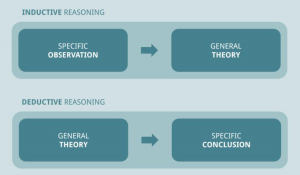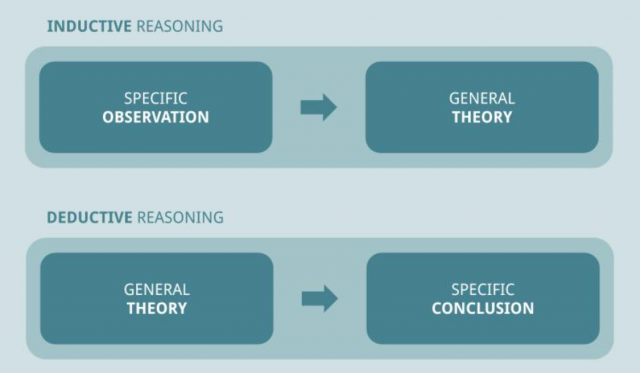
When it comes to data science, there are two main types of reasoning that you need to be familiar with: deductive and inductive. Both of these techniques are important in order to make sound decisions based on the data that you’re working with. In this blog post, we’ll take a closer look at what deductive and inductive reasoning are, what are their differences, and how they’re related to each other.
What is deductive reasoning?
Deductive reasoning is an important tool in data science. Deductive reasoning is the process of deriving a conclusion based on premises that are known or assumed to be true. In other words, deductive reasoning allows you to make inferences based on what you already know. An example of deductive reasoning:
If all humans are mortal, and John is a human, then John is mortal.
In this example, we can see that the conclusion (John is mortal) is drawn based on the two premises (all humans are mortal, and John is a human).
Here is another example. If you know that it has rained every day for the past week, you can use deductive reasoning to conclude that it is likely to rain today.
Deductive reasoning is often used in data science to laying down the hypothesis and then test it through deductive techniques. A deductive technique called “affirming the consequent” can be used to test hypotheses. In this technique, we start with a hypothesis and then look for evidence that supports it. If the evidence supports the hypothesis, then the hypothesis is likely to be true. The following are some of the steps for deductive reasoning in relation to hypothesis testing:
- Hypothesis formulation: The first step is to formulate the hypothesis. The hypothesis should be based on your research question. The hypothesis formulation results in the null and alternative hypotheses. Check out this blog post on hypothesis formulation.
- Data collection: The next step is to collect data that can be used to test the hypothesis.
- Data analysis: Once you have collected the data, you need to analyze it in order to see if it supports your hypothesis.
- Determine test statistics: The next step is to determine the test statistics. The test statistics will help you to determine whether or not the null hypothesis can be rejected.
- Calculate p-value: The last step is to calculate the p-value. The p-value is used to decide whether or not to reject the null hypothesis.
- Conclusion: Finally, you can reach a conclusion based on the p-value. If the p-value is less than 0.05 (level of significance), you can reject the null hypothesis and conclude that the alternative hypothesis is true.
What is inductive reasoning?
Inductive reasoning is another important tool in data science. Inductive reasoning is often used in data science to make predictions based on limited evidence. Essentially, it involves taking a small sample of data and using it to infer information about a larger population. For example, let’s say you want to predict how many people will attend your company’s holiday party this year. To do this, you could survey a few employees and ask them how likely they are to attend. Based on their responses, you could then make a prediction about the overall attendance rate. Inductive reasoning can be useful when trying to generate hypotheses or make generalizations, but it’s important to remember that it’s based on limited evidence. As such, inductive reasoning should always be used in conjunction with other methods of inquiry such as deductive reasoning.
The figure below represents the concepts of deductive and inductive reasoning described above. Note that inductive reasoning is about starting from data or observations and reaching to conclusion while deductive reasoning is about starting from a hypothesis (claim) and using data or observation to accept the claim or otherwise.
How deductive and inductive reasoning are different?
The following represent key differences between deductive and inductive reasoning:
- Deductive reasoning is based on known or assumed truths (hypothesis), while inductive reasoning is based on limited evidence.
- Deductive reasoning allows you to make inferences about what you already know, while inductive reasoning allows you to make predictions about what you don’t know.
- Deductive reasoning is a top-down approach, while inductive reasoning is a bottom-up approach.
- Deductive reasoning is deductive because the conclusion must be true if the premises are true, while inductive reasoning is only probable because the conclusion may or may not be true even if the premises are true.
How is deductive and inductive reasoning used in data science?
When working with data, it is important to be able to use both inductive and deductive reasoning. Inductive reasoning is based on making observations and then generalizing from those observations. For example, if you observe that all of the cats in your neighborhood are black, you may conclude that all cats are black. In contrast, deductive reasoning is based on making a generalization and then applying it to a specific situation. For example, if you know that all cats are animals, and you see a black cat, you can deduce that the cat is an animal. In data science, both inductive and deductive reasoning are important. Inductive reasoning is often used to generate hypotheses that can be tested with data. Deductive reasoning is often used to test those hypotheses and reach conclusions.
Inductive reasoning is often used in data science when making predictions. This type of reasoning starts with specific observations and then draws general conclusions from them. For example, if a data scientist notices that sales of a certain product tend to increase during the summer months, they can use inductive reasoning to predict that sales will continue to rise in future summers. Deductive reasoning, on the other hand, involves starting with general principles and then applying them to specific cases. In data science, deductive reasoning is often used to test hypotheses. For instance, if a data analyst believes that a certain marketing campaign will lead to increased sales, they can use deductive reasoning to develop a test that will determine whether or not their hypothesis is correct. By using both inductive and deductive reasoning, data scientists can develop a well-rounded understanding of the data they are working with.
Both deductive and inductive reasoning are important tools in data science. By understanding the difference between these two types of reasoning, you can more effectively use both to reach sound conclusions based on data.
Summary
The difference between deductive and inductive reasoning is important for data science. Deductive reasoning starts with general principles and then applies them to specific cases, while inductive reasoning starts from observations or assumptions, drawing general conclusions from these limited bases of knowledge. While deductive reasoning can be useful in testing hypotheses through deducting the implications of those theories, inductive reasoning is more often used when making predictions from data. However, both deductive and inductive reasoning are important tools in data science that should be understood in order to use them effectively. Do you have any questions about deductive or inductive reasoning? Let us know in the comments below.
- Coefficient of Variation in Regression Modelling: Example - November 9, 2025
- Chunking Strategies for RAG with Examples - November 2, 2025
- RAG Pipeline: 6 Steps for Creating Naive RAG App - November 1, 2025

I found it very helpful. However the differences are not too understandable for me